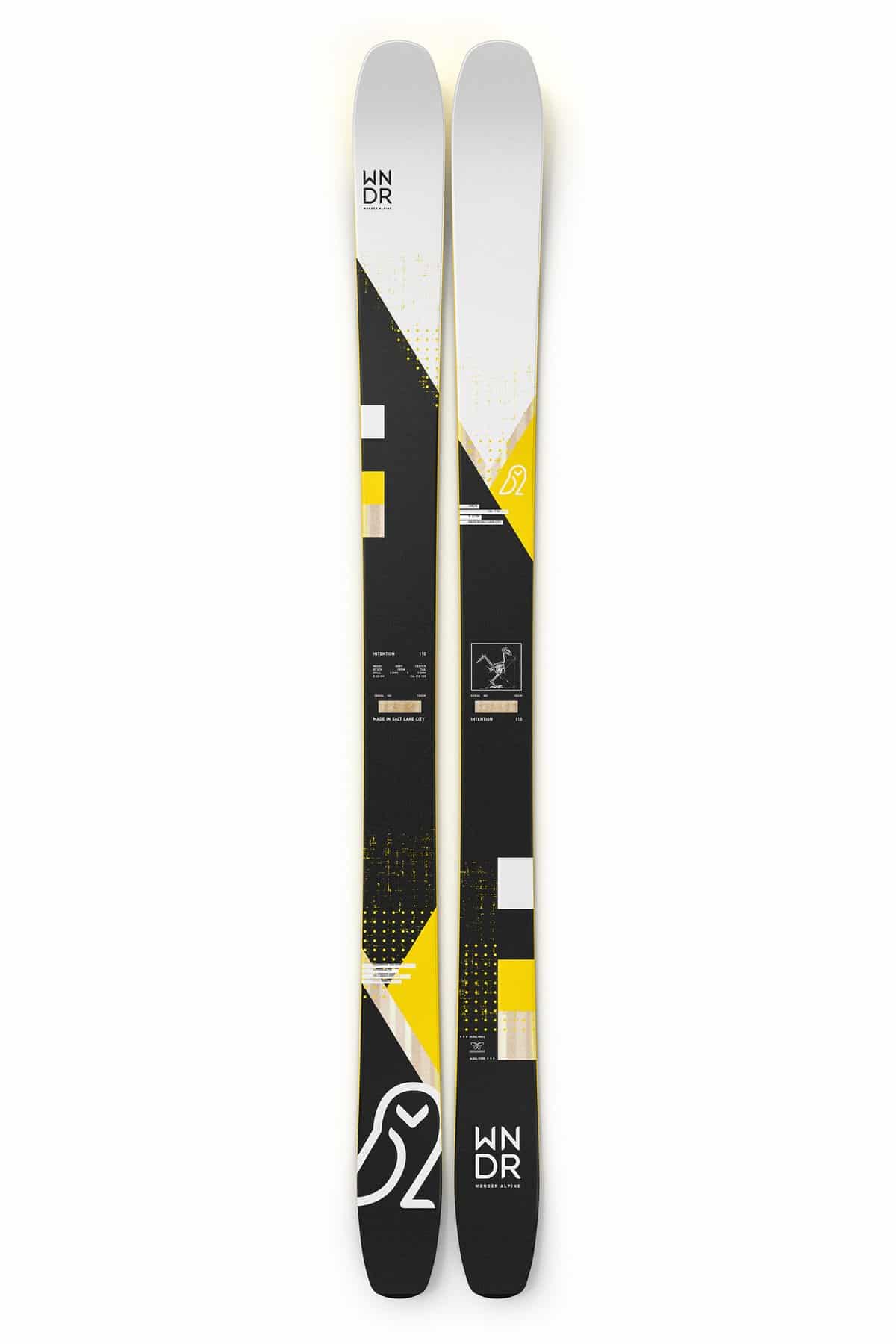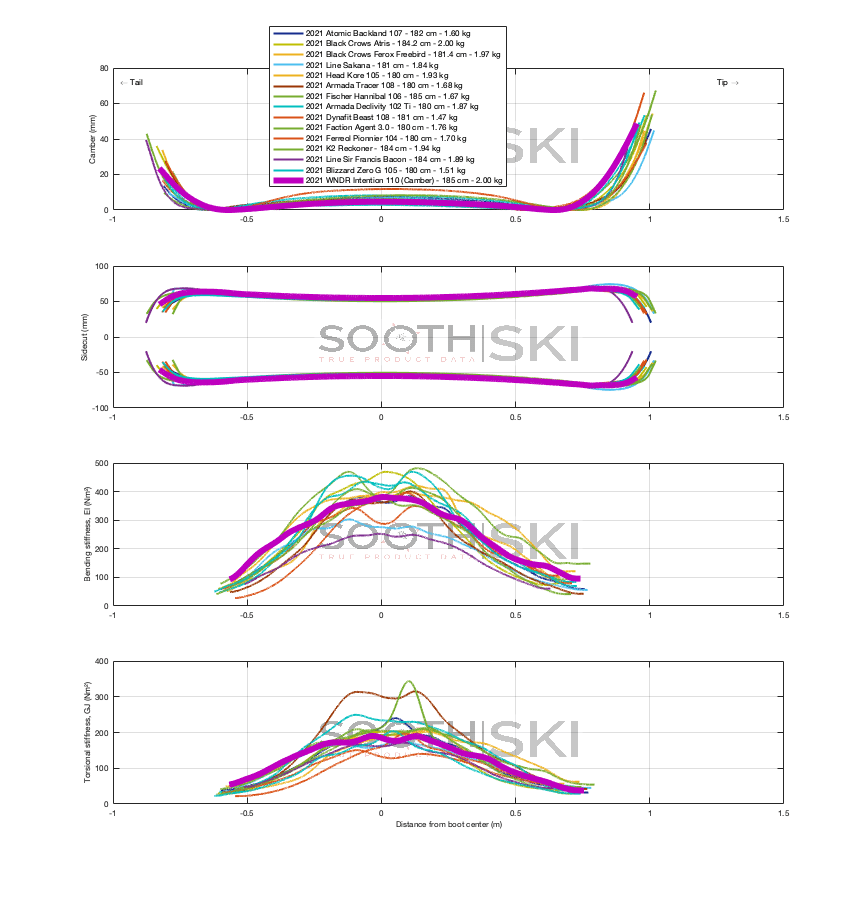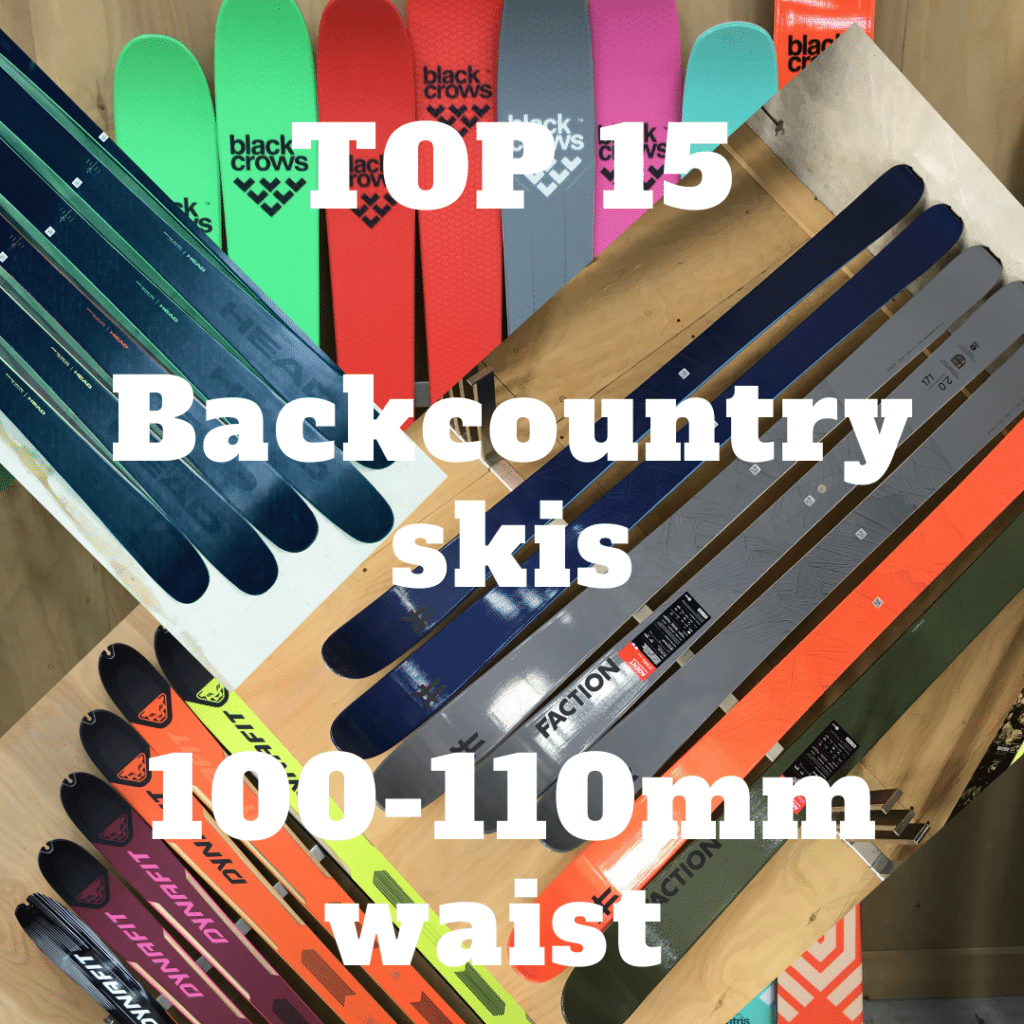My last post about backcountry gear was shared a few times and I got a few requests to write something for the 100-110mm range underfoot. Luckily, we also have a couple of new brands that match this condition and I’m stoked to feature them in our online free measurements to compare.
The list below matches a precise set of criteria, but if those don’t match what you’re looking for, you can go to our Ski Data page and filter for your own personal criteria. A good deal of measurement is free and some comparison charts are generated automatically.
My selection for this article corresponds to skis that match the following:
- 100 to 110mm underfoot
- 180 to 185cm length
- Under 2000g
- Only 2021 models
The resulting options are 15 distinct skis that can have very different feelings on the snow. The online table available in the ski data section provides you with over 20 specific measures for each ski. Those measures are:
Nominal information (provided by the manufacturer)
- Radius (m)
- Tip (mm)
- Waist (mm)
- Tail (mm)
Measured & calculated information by Sooth Ski technology:
- Length (cm)
- Masse (g)
- Radius (m)
- Tip (mm)
- Waist (mm)
- Tail (mm)
- Effective edge length (cm)
- Camber height (mm)
- Average bending stiffness Ei (Nm2)
- Average torsional stiffness Gj (Nm2)
- Area (cm2)
- Tip length (mm)
- Tip height (mm)
- Tip taper length (mm)
- Tail length (mm)
- Tail height (mm)
- Tail taper length (mm)
- Surface/weigh ratio (cm2/g)
Other:
- MSRP($CAN)
As far as I know, we’re the only website that provides this kind of information.

Navigating this information can be a challenge, even for experienced salespersons in shops. Keep in mind that for any given salesperson, it’s virtually impossible to test all those skis in a given season and remembering the specific feelings of each is impossible. As a result, I’m always skeptical that we get perfect guidance for our next purchase. That’s where our measures become handy, and even better, a ski fit by Sooth makes a lot of sense!
Comparing average levels of bending and torsional stiffness
The quick way to get an idea of the on-snow feelings of those options is to plot the average bending stiffness versus the average torsional stiffness. We’ve done this kind of analysis for various all-mountain options already for men and for women’s skis. The image below is not interactive, but when you use the online table in the members area, you get more information on the chart as you select a specific bubble.

Bending stiffness and torsional stiffness average values
This chart is packed with valuable information. See our member area for better understanding. You get the mass, the radius, the average flex level in bending and in torsional stiffness. Before starting anything too specific, let’s state some overall facts:
- There’s a bunch of skis that seem very similar in the center. Faction Agent 3.0, WNDR Alpine Intention 110, Black Crows Altris, Black crow Ferox Freebird & Atomic Backland 107. Each of those have specific variations, you can consult the details below.
- Armada Tracer 108 is a lot stiffer in torsion compared to all the others. In fact, it has 16% higher torsional stiffness than the second highest, which is the Armada Declivity 102 Ti and a whopping 75% stiffer than the Blizzard Zero G. Yet, the weight is very acceptable at 1677g.
- The lowest bending stiffness is scored by Line Sir Francis Bacon. The highest of the list is the Fischer Hannibal 106 which is 60% higher on bending stiffness.
As I always say, the average value is good to compare, but it’s far from giving the whole picture, as the local stiffness of the fore/aft and tip/tail areas influence a lot some specific feelings while skiing.
Surface/Weight ratio compared with ski waist width
Another great chart we provide is the surface/weight ratio and the waist width. It’s one thing to have a light ski, but you still want a good surface area to get a good float. This chart is fairly simple to read. The higher the bubble, the better it is on that perspective. I would still argue that one can save a few grams on his skis but can also save a lot more on what he’s carrying, including his own body weight!

Surface/Weight ratio compared with waist width
15 backcountry skis detailed features
The following section is information we are able to extract from our complete measurements. Each ski has its own properties, kind of like a DNA. When you request a ski fit, we basically match your biometrics, the feelings you like and your skiing ability to the proper ski based on its DNA.
2021 Armada Tracer 108 180cm
Armada made a flexible ski for bending values and stiff on torsional values. The speed limit of this ski may be lower, but it also provides a highly adaptative and reactive ski. The snow and terrain variations will be easy to deal with, considering the tip and tail are not stiff. At 1677g, it is also the fourth lightest of the selection, equal to the Fischer Hannibal 106. For tight turns and reactiveness on piste, this ski will perform among the best. It is also suitable for tight glades as we often ski in the East Coast.
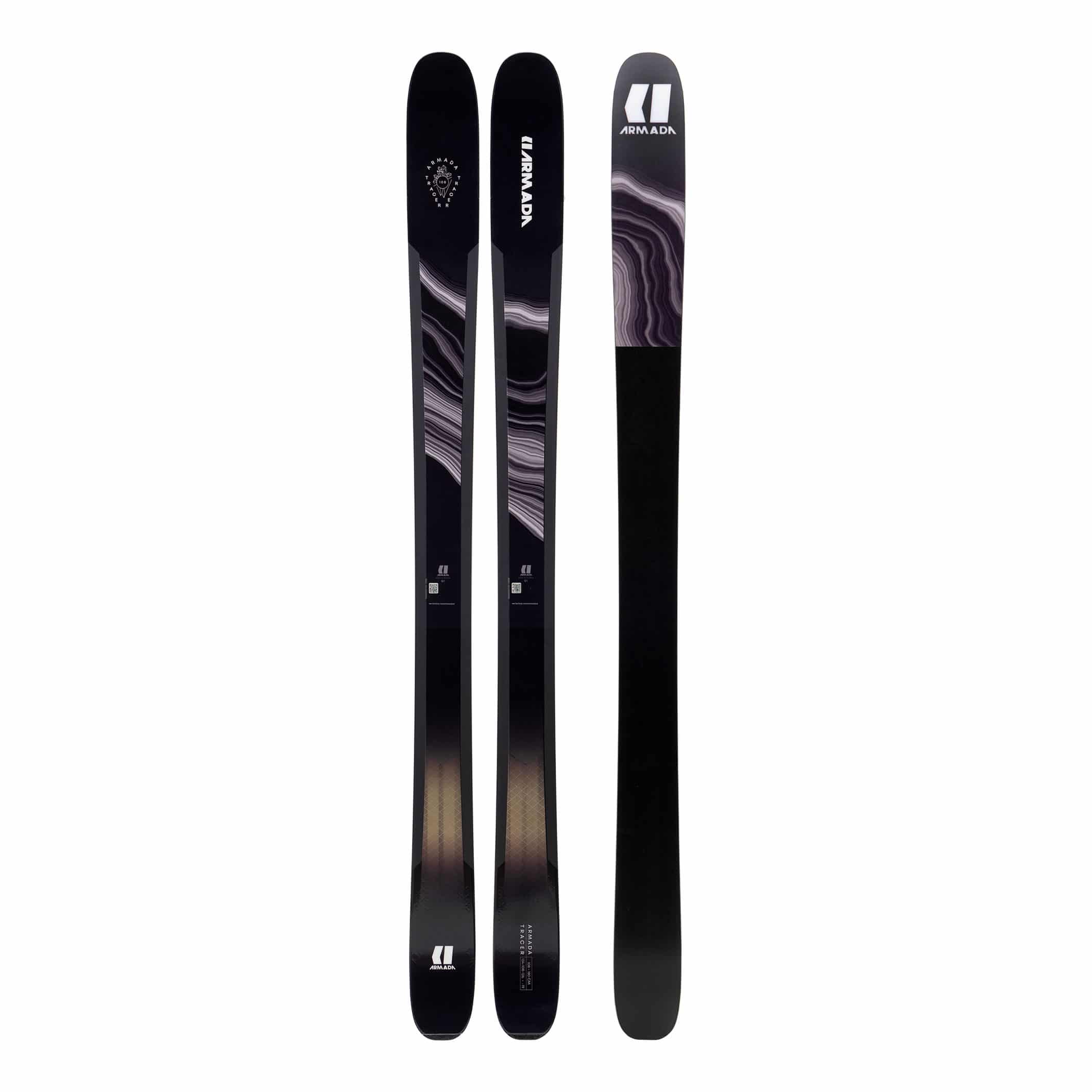
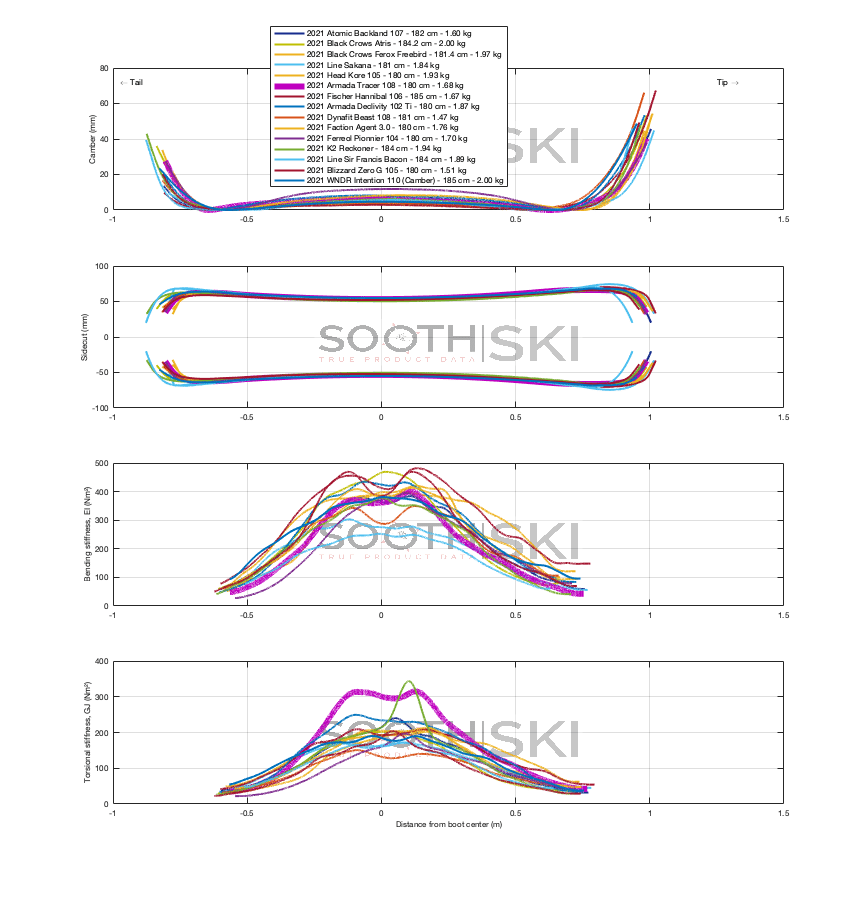
2021 Armada Declivity 102 Ti 180cm
Armada’s Declivity 102 Ti is slightly above average in both bending and torsional stiffness values. This is a ski suitable for about everything. With an 18m radius, it can be seen as suitable for on piste as well, like the Head Core 105. The torsional stiffness is well above average, which will procure superior edge grip. The tail area has slightly lower bending stiffness values, so this ski will be playful and turn easily.
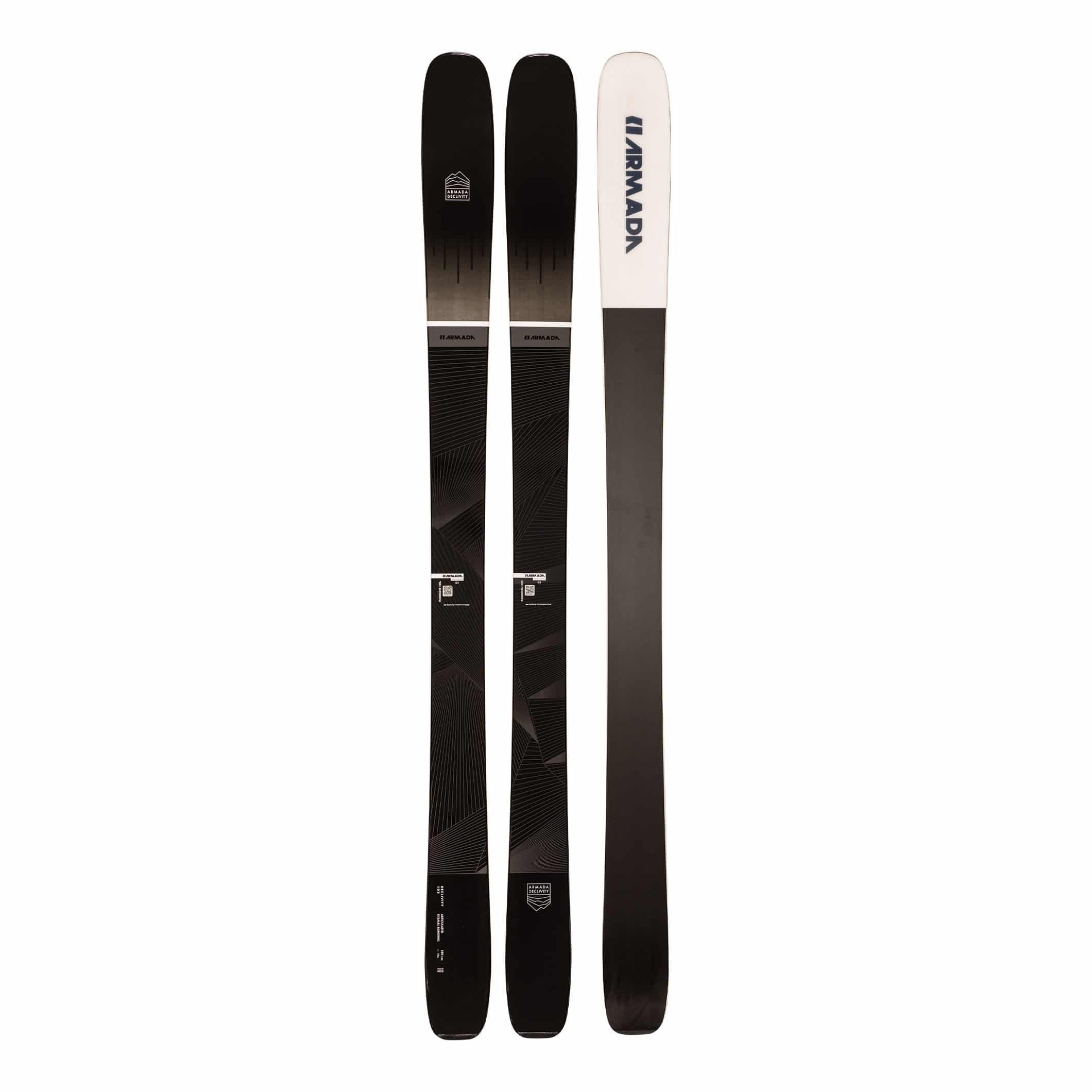
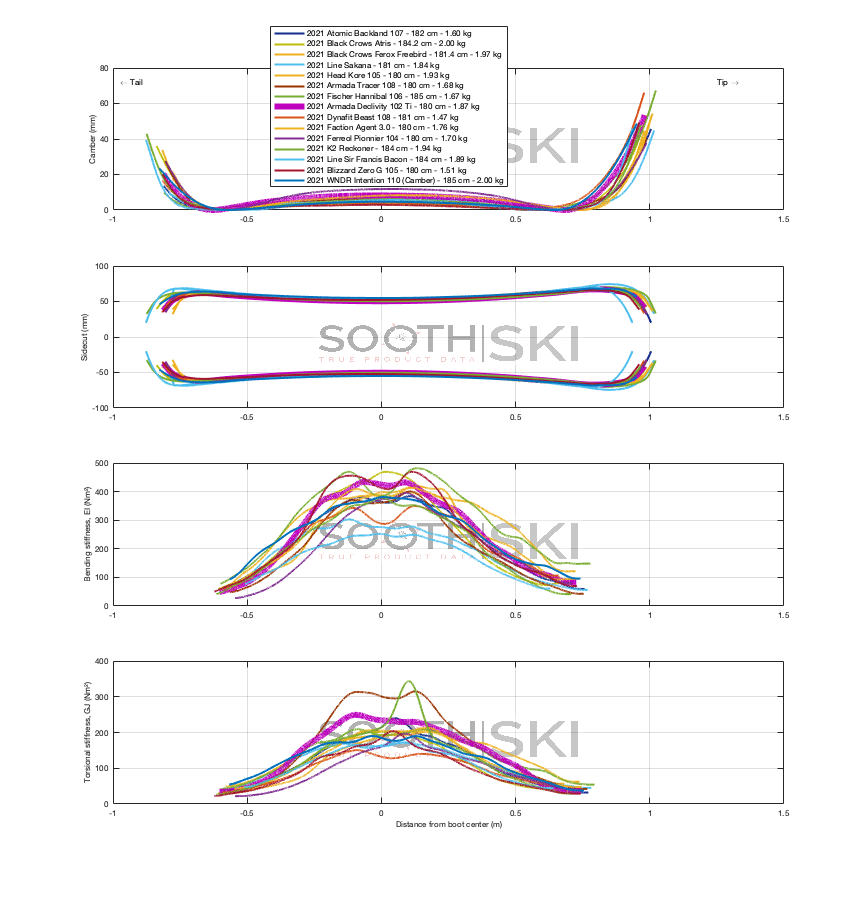
2021 Atomic Backland 107 182cm
The Atomic Backland 107 is a balanced average among all those skis. It doesn’t stick out in any way that you would be surprised with it on the slopes. Considering the weight at 1605 grams, one could expect this ski to be low on stiffness, but it’s not the case. After Blizzard and Dynafit, it’s got the 3rd highest surface/weight ratio of this selection, while maintaining a higher level of torsional stiffness, meaning it will grip fairly well. A great choice for someone who’s looking for a lightweight ski that will deal with any conditions.
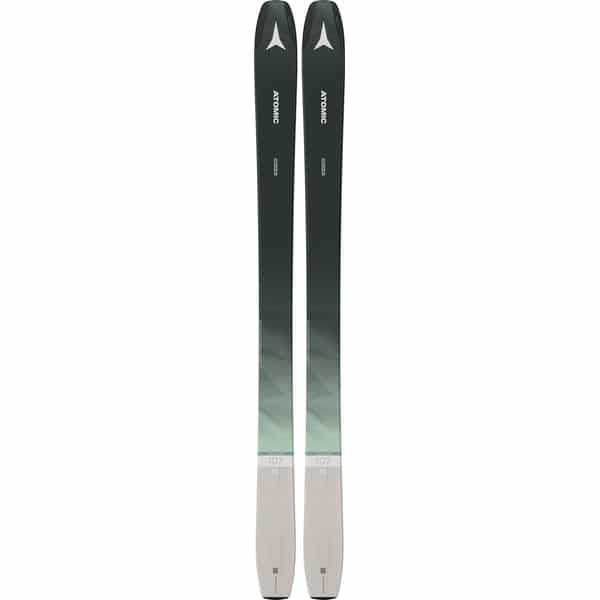
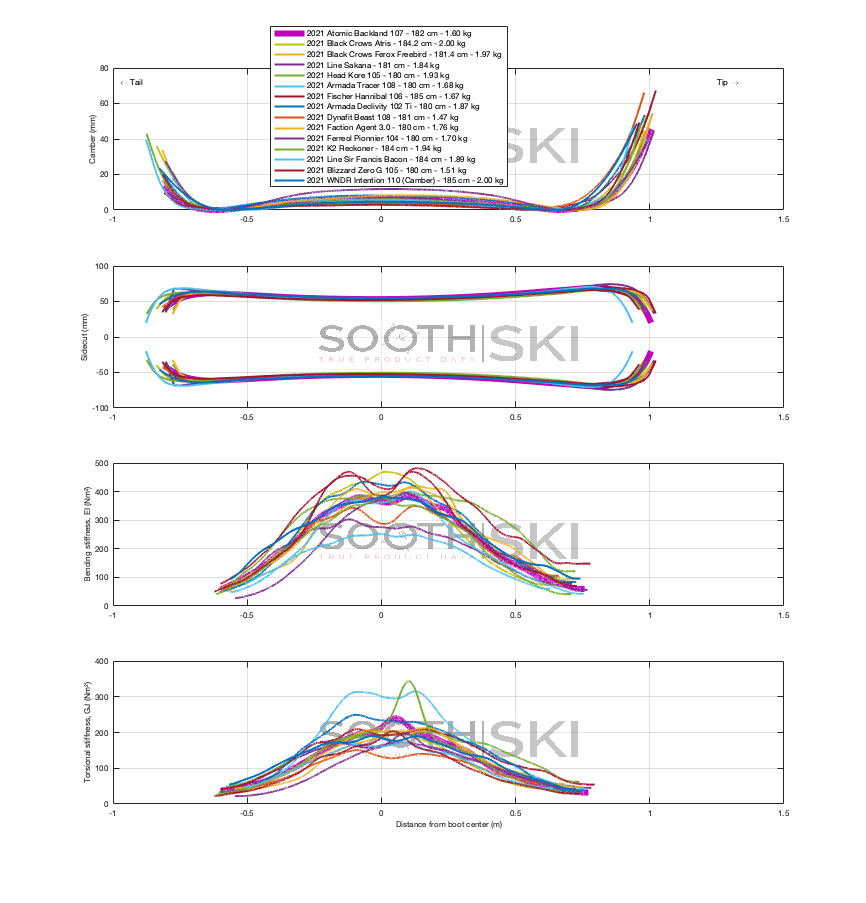
2021 Black Crows Ferox Freebird 181cm
The Black Crows Ferox Freebird has a flexible tail area in both bending and torsion. As for the front part, it’s among the stiffest in bending and average in torsion. To me, this translates into a ski that will be easier to maneuver in tight areas or when the snow is “heavy”, such as dense or corn type snow. It’s “surfier” than the average.
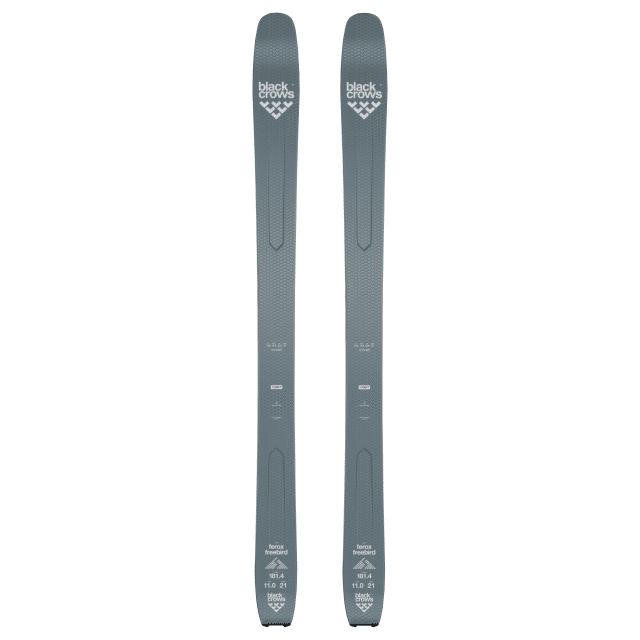
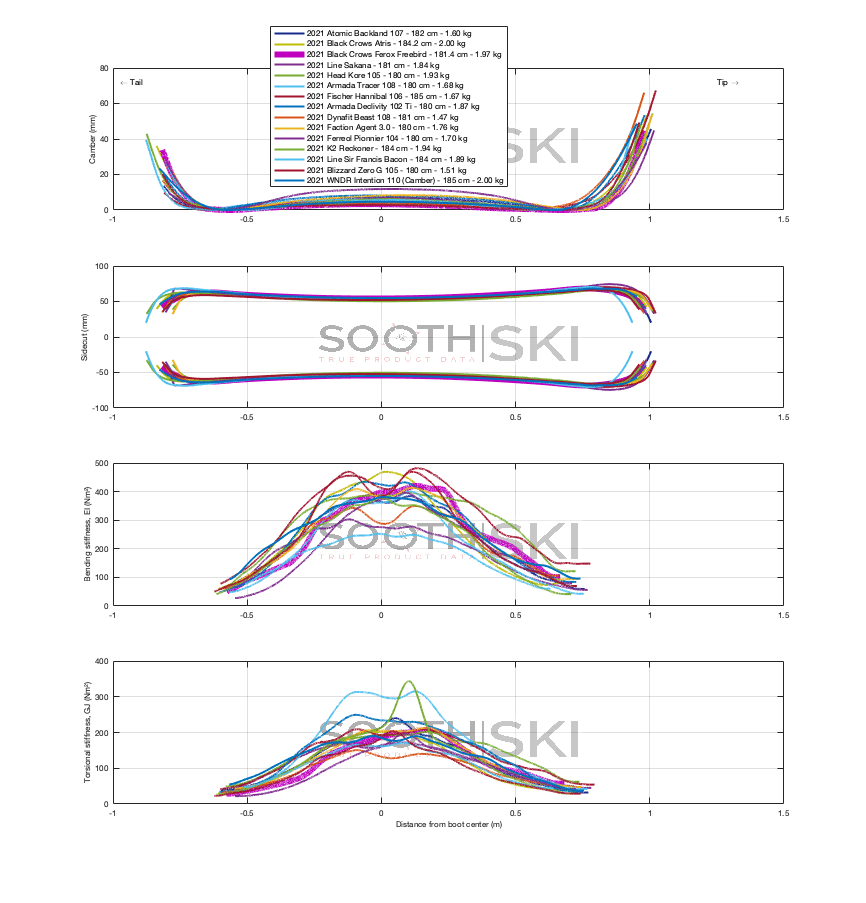
2021 Black Crows Altris 184cm
The Black Crows Altris has a softer bending and torsional stiffness than most of the skis in this selection. A soft front area will make it easier to handle the terrain variation including the snow conditions. This means more forgiving, especially in the turn initiation part. The back part of the ski is more or less average with the others. Skiers that will be dealing with a variety of snow condition and bumpy terrain will appreciate this property. With one of the largest radius of this selection, it would be more suitable for wide open areas where large turns are the norm when you do that occasional on piste descent.
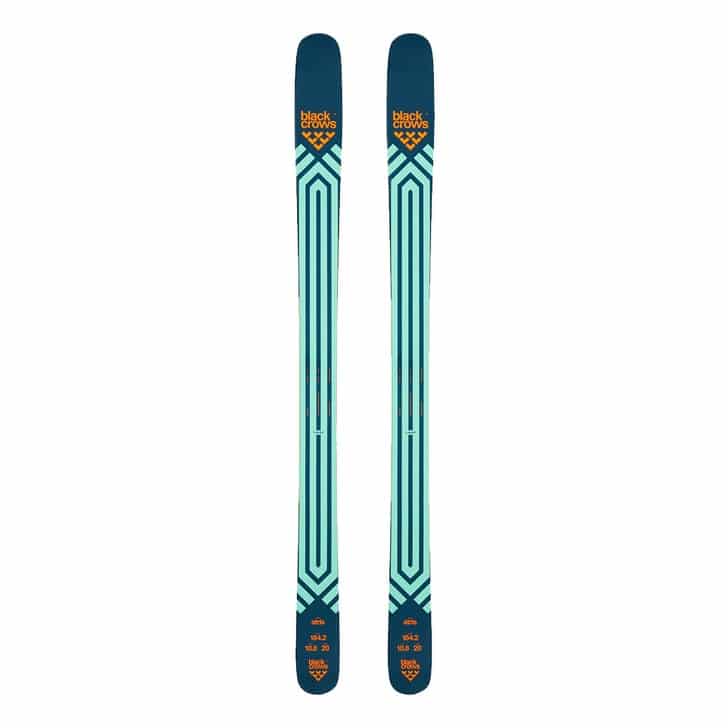
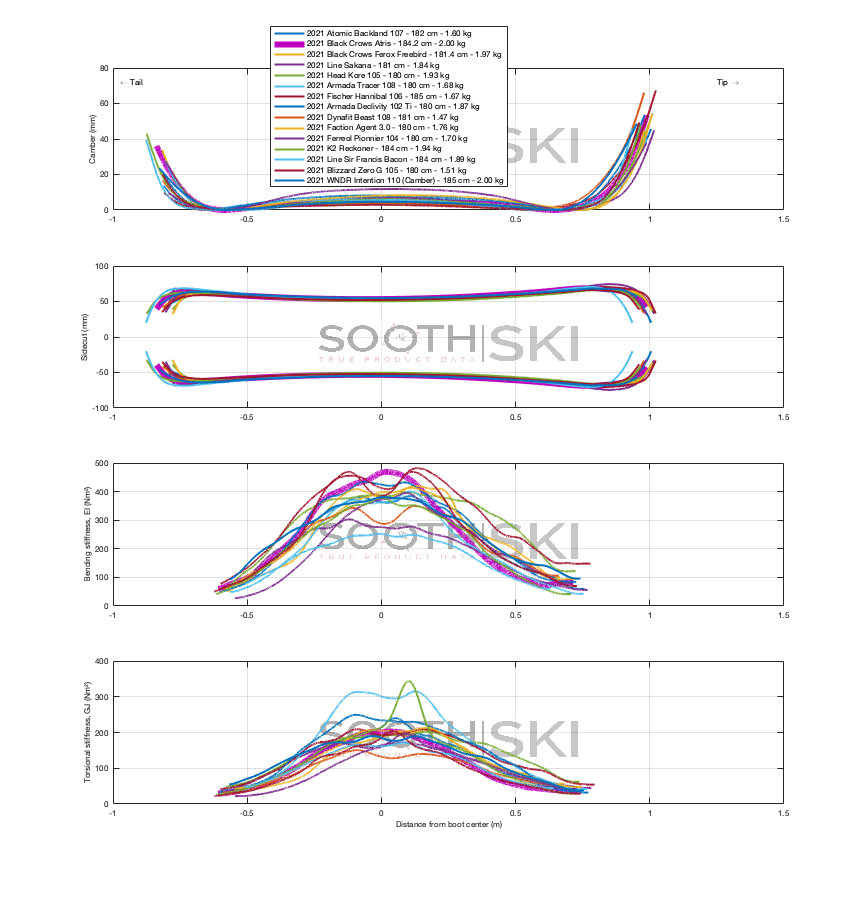
2021 Blizzard Zero G 105 180cm
They are known for their incredibly light construction and I can confirm, this is the second lightest of the selection, right after the Dynafit Beast. It has a flat camber and the second-best surface/weight ratio. This is for the one who seeks lightweight gear. The bending stiffness values are high, so this ski is stiff, and you can push the speed a lot. This is the main difference with the Dynafit Beast, which is far more flexible. As for torsional stiffness, this is where the compromise happens, its flexible, playful, but limited edge grip.
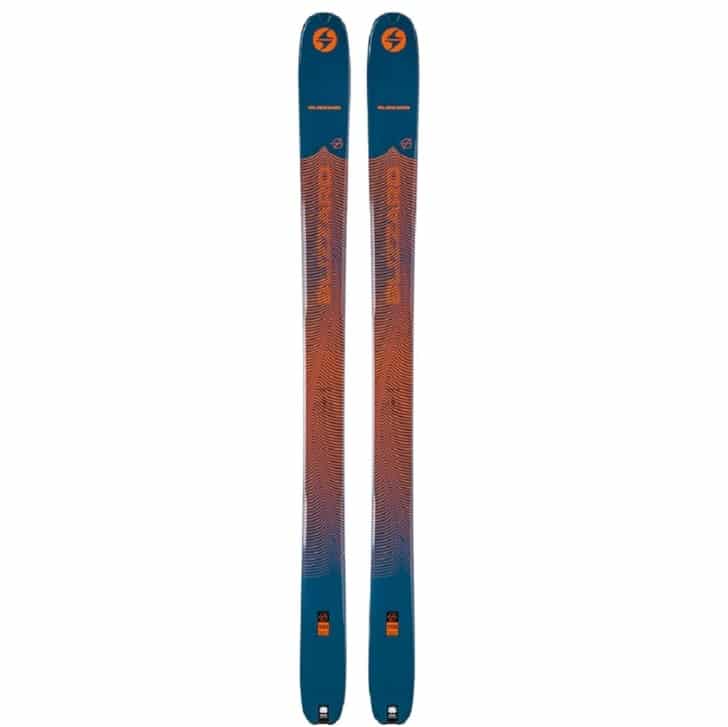
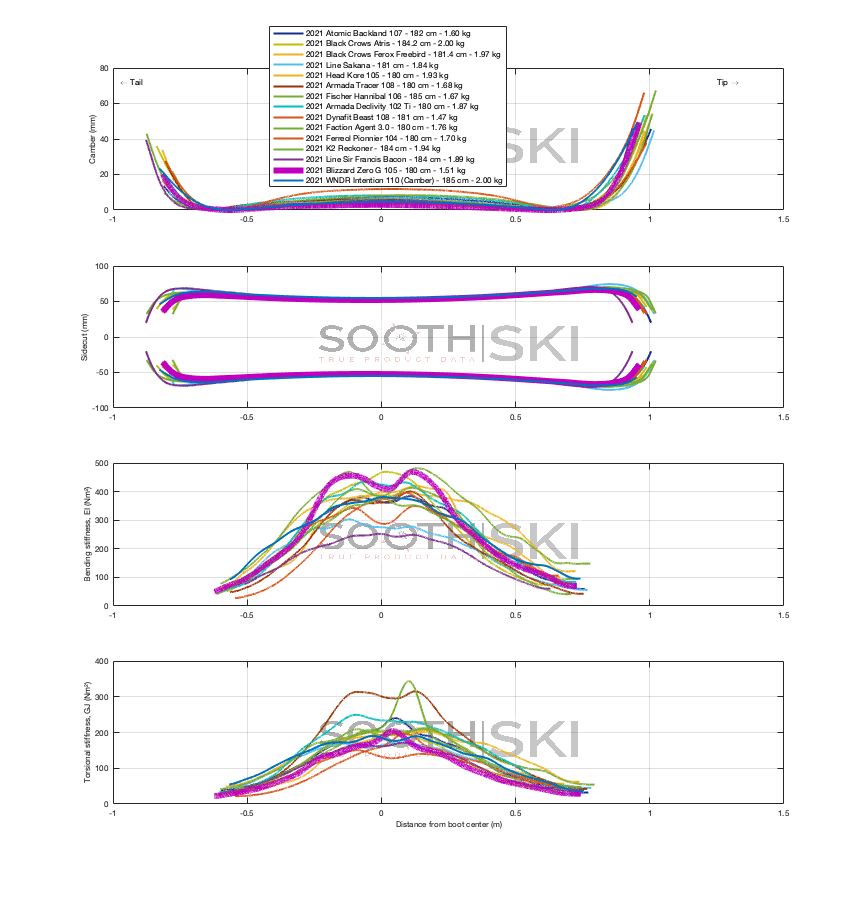
2021 Dynafit Beast 108 181cm
This is the ski that ranks at the first place in the surface/weight competition. For those who want lightweight and float as a top priority, the options are the Dynafit Beast and the Blizzard Zero G right behind. At this level of mass, it’s hard to make a stiff ski as well. So both the Beast and the Zero G rank with the lowest values for torsional stiffness. In other words, don’t bring those too often on hard pack snow or on piste… that’s the tradeoff. Despite this, the bending stiffness values of the Dynafit Beast is right on the average, above the Zero G.
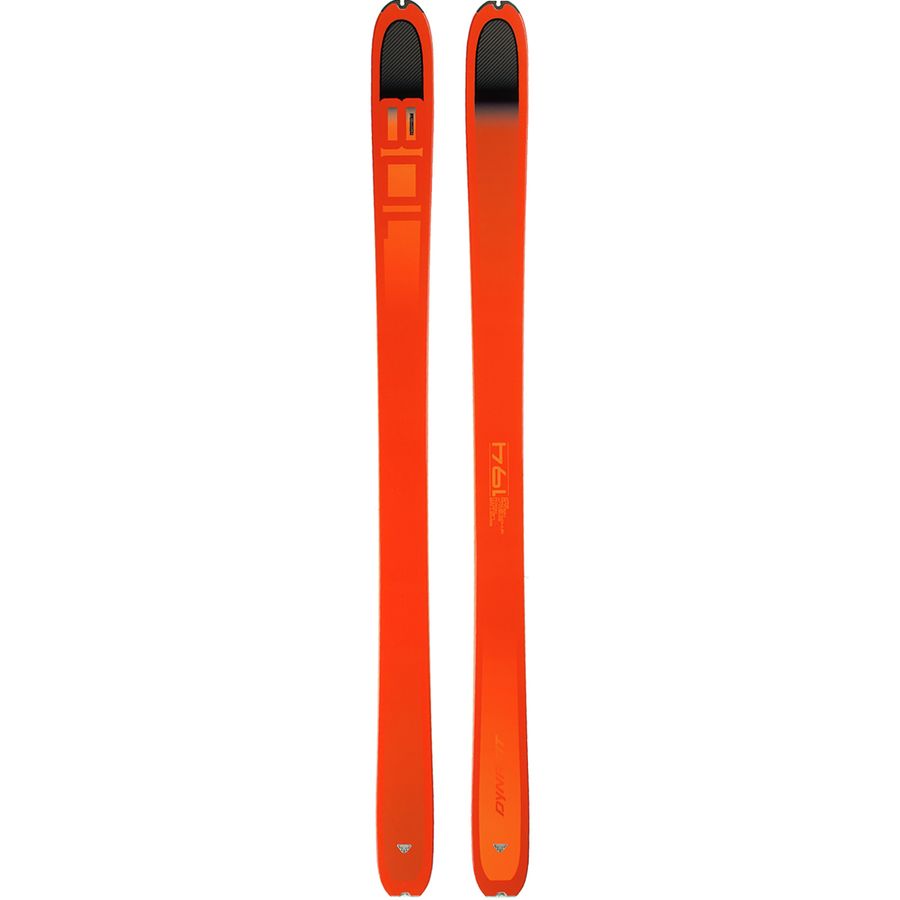
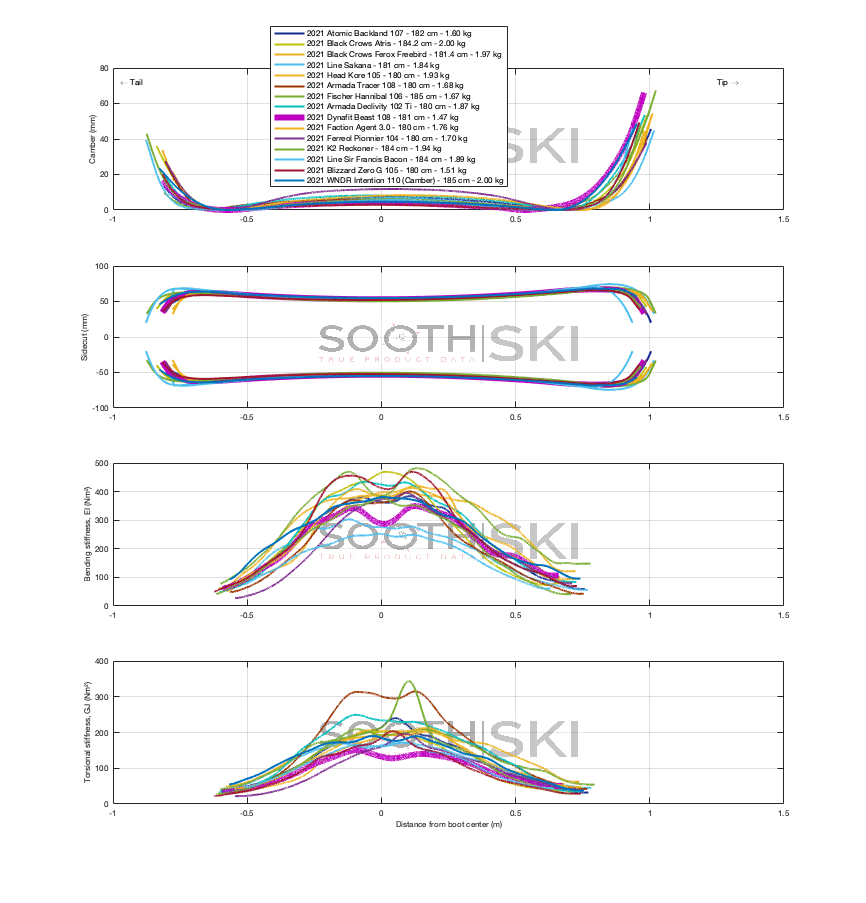
2021 Faction Agent 3.0 180cm
The Faction Agent 3.0 has about the same properties as the Atomic Backland, but slightly stiffer overall, in both bending and torsional values. This ski will perform in about anything very well. It has about 150 grams more than the Backland but remains better than average on the scale for this selection. A great ski for the ones who want to travel, as it will handle about anything.
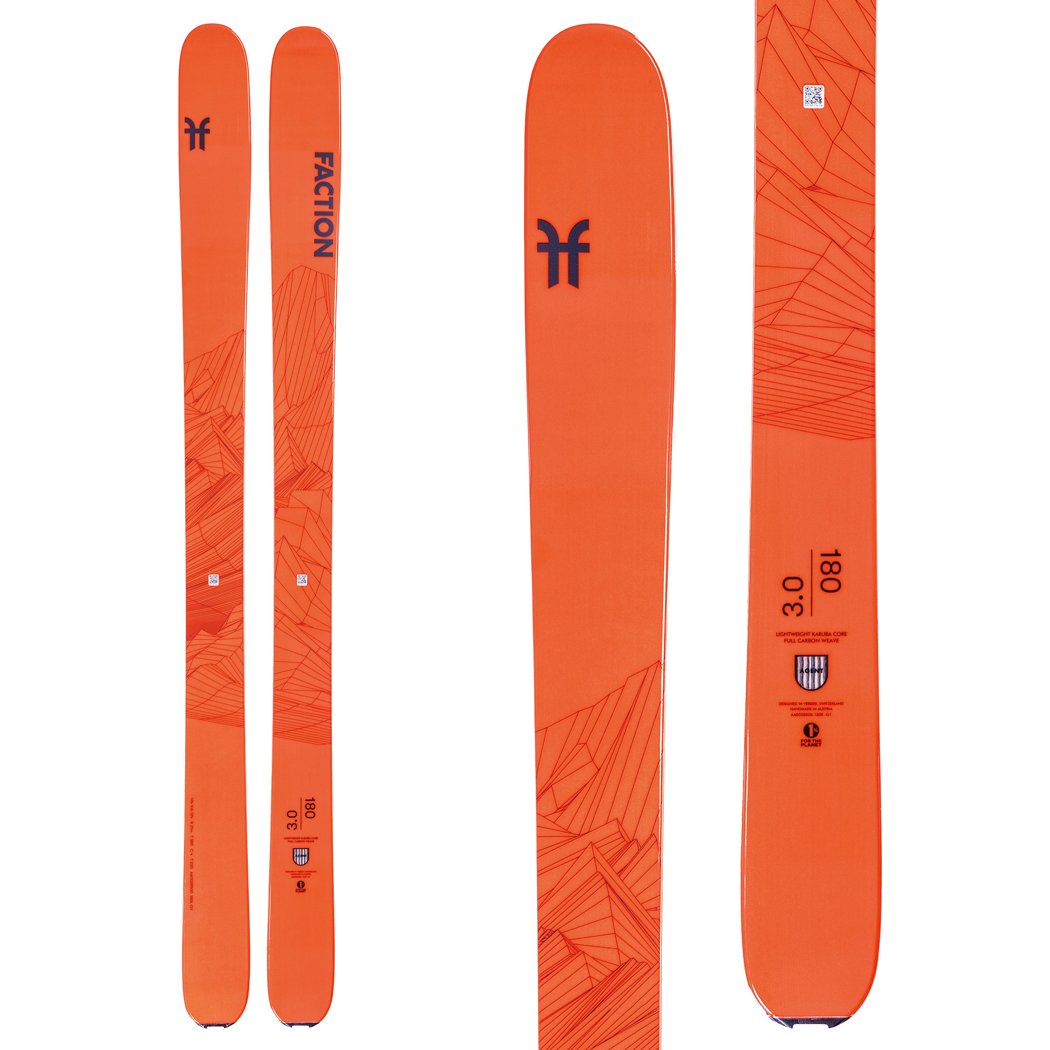
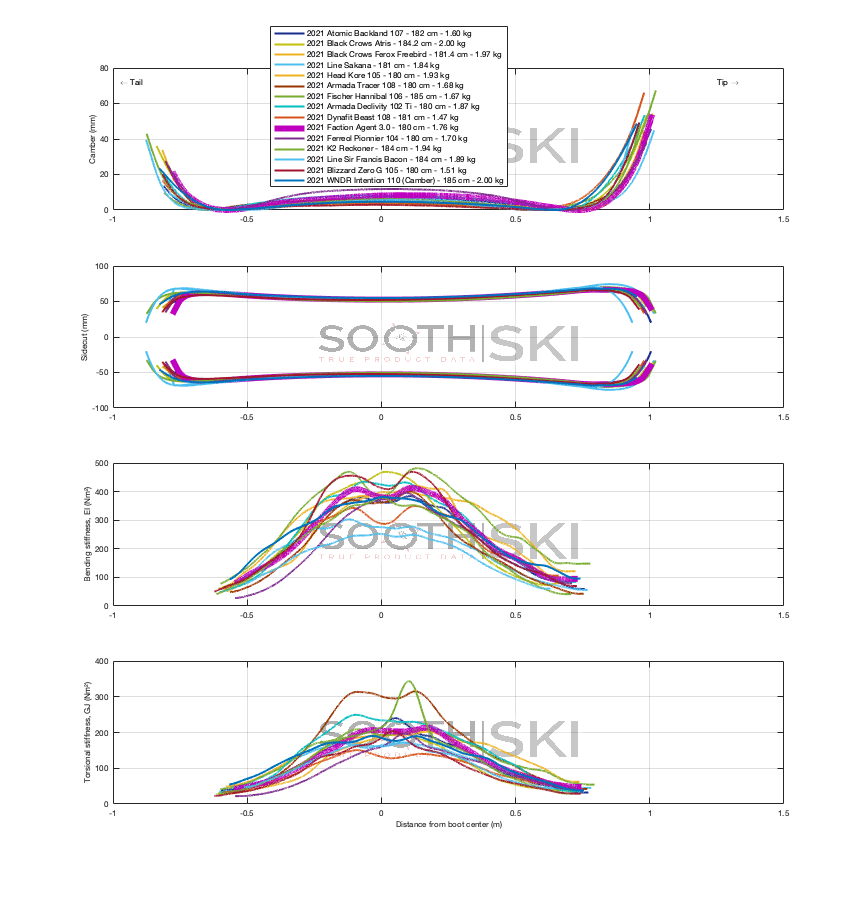
2021 Ferreol Pionnier 104 180cm
Ferreol is new to our database this year. At this stage, this is the only model in production for this brand. Just under 1700 grams, this ski has ranked very well in the surface/weight ratio. What stands out is the short radius of 16m. This ski will turn very well on piste, so very suitable for backcountry skiers who will use this ski in the resorts once in a while. It has clearly the most flexible tail area in both bending and torsional values. This procures an ability to turn and react quickly, well appreciated in the tight east coast glades. This ski will be playful in mixed snow conditions and in corn snow, where it will provide superior surfy feelings.
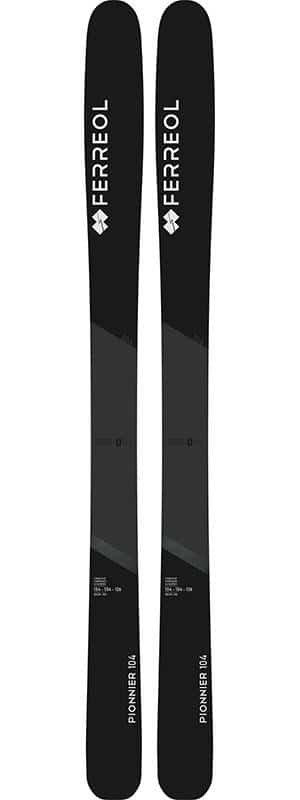
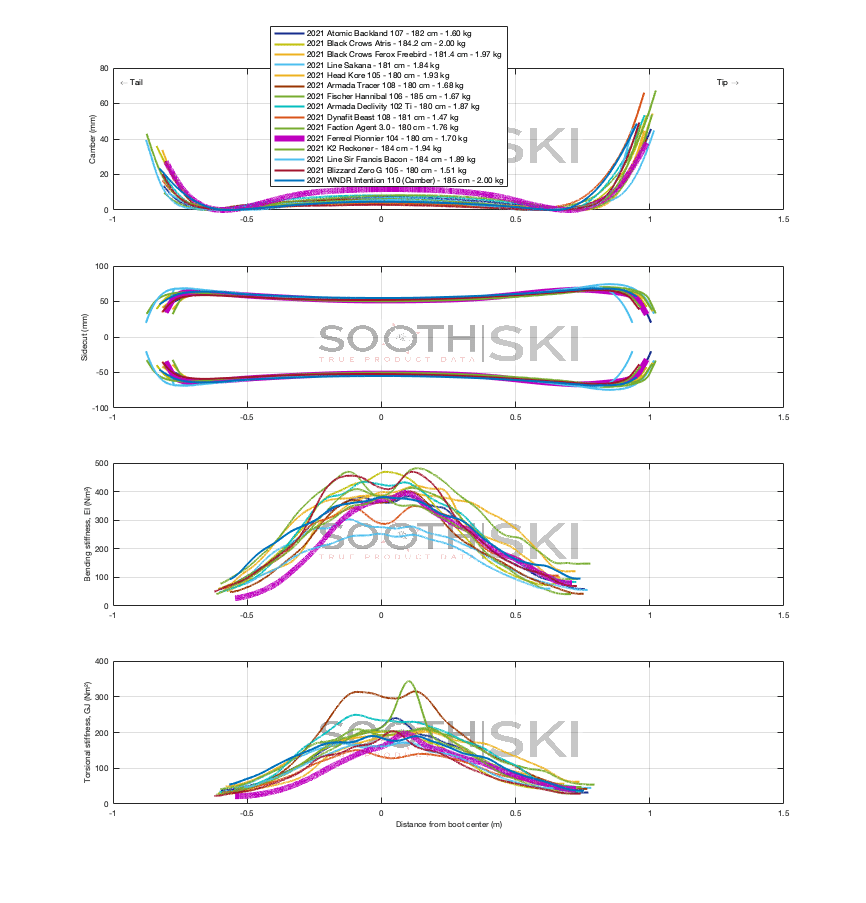
2021 Fischer Hannibal 106 185cm
If you’re looking for a combination of stiff and lightweight, this is probably the best option int this selection. Very close to the Head Core in terms of stiffness, but a lot lighter (300g). One big difference with the Head Kore would be the sidecut. The Hannibal has a longer radius, so less reactive than the Kore 105 on piste. Considering the bending stiffness value, you can push the speed on this ski without a problem! It competes very well in the surface/weight ratio at the 4th place.
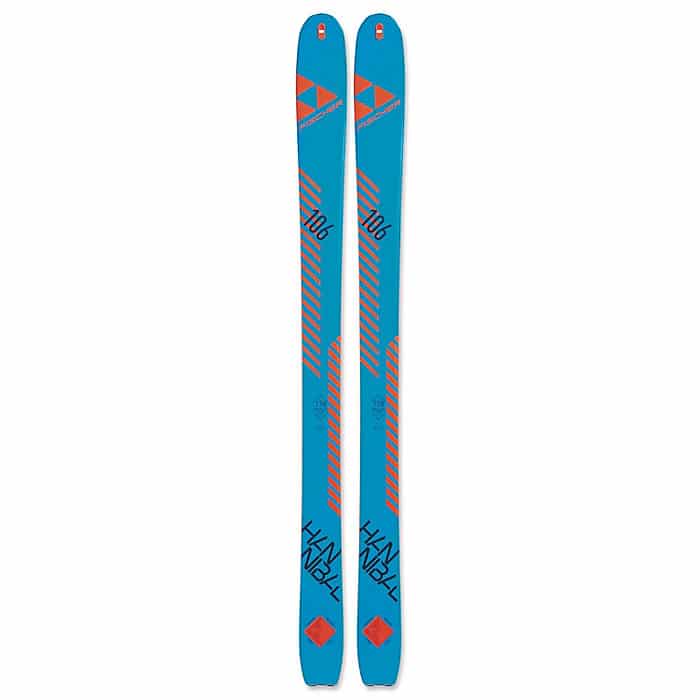
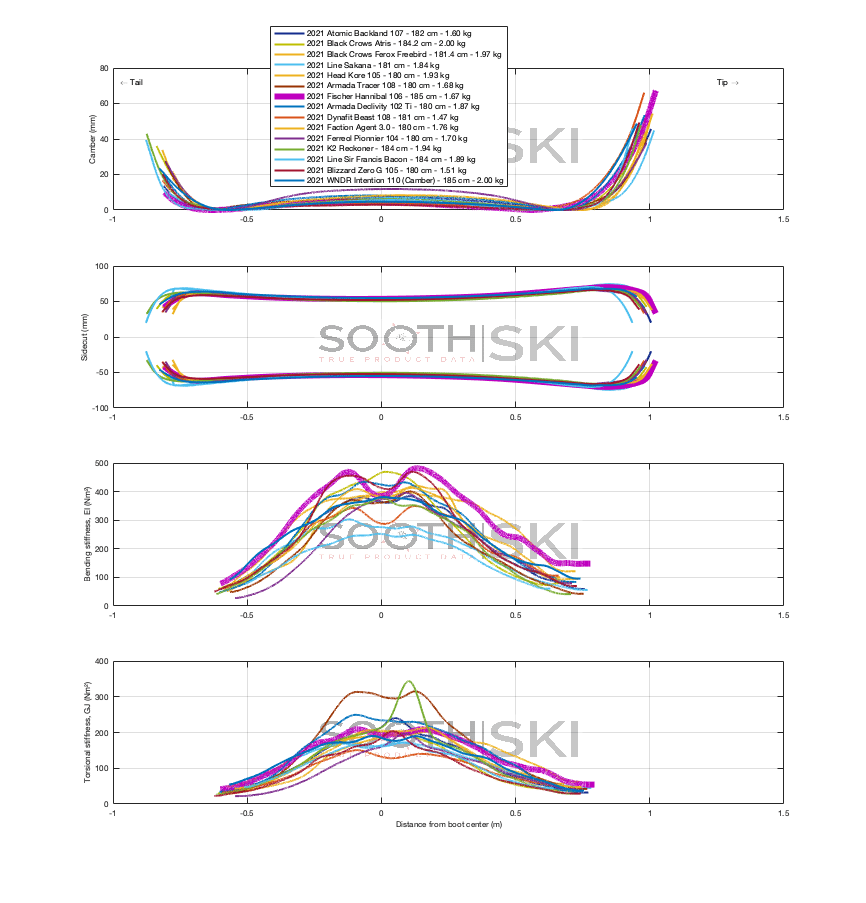
2021 Head Kore 105 180cm
The Head Kore has arguably the highest bending stiffness values of this selection of skis. Both front and rear areas are stiffer that the rest, so this is the ski you want if you expect to ski fast. The torsional stiffness in the front area is also very high. This provides a far superior edge grip in the turn initiation phase. This kind of ski suites more technically advanced skiers that welcome edge performance even for a large ski. It is less forgiving, but considering the smaller radius, this ski can turn, react and perform on piste as well.
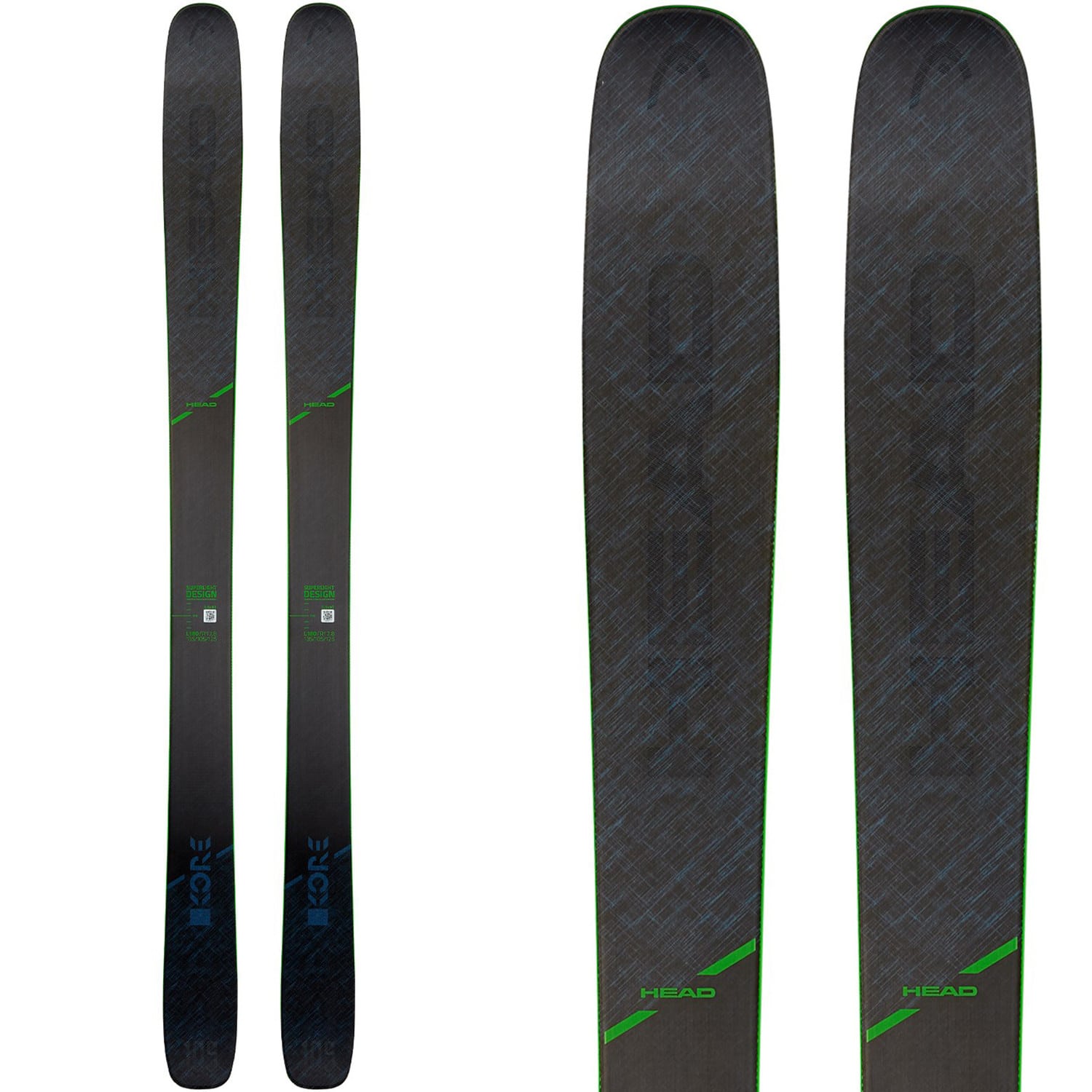
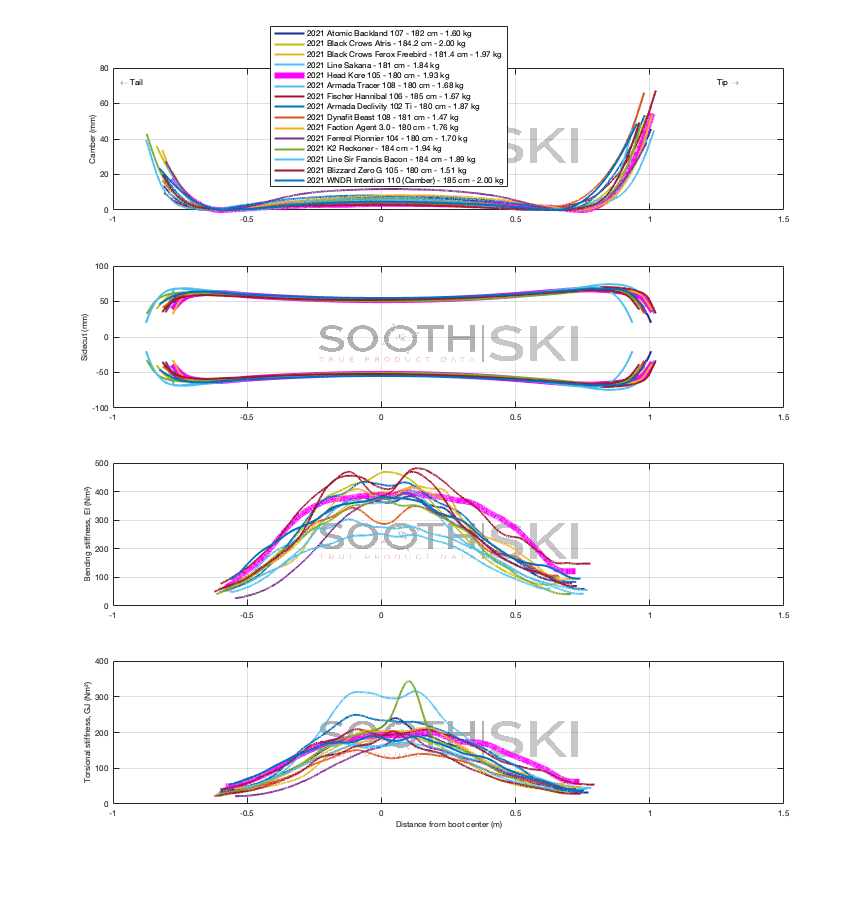
2021 K2 Reckoner 102 184cm
K2 Reckoner is a ski in the low average of bending and torsional stiffness values within this selection. While the tail area is on the average, the tip area is less stiff, so this ski will forgive well in variable snow and terrain conditions. Similar to the Atomic Backland and the Faction Agent 3.0, this is a sure shot to meet most of the needs, suitable for everything and anything.
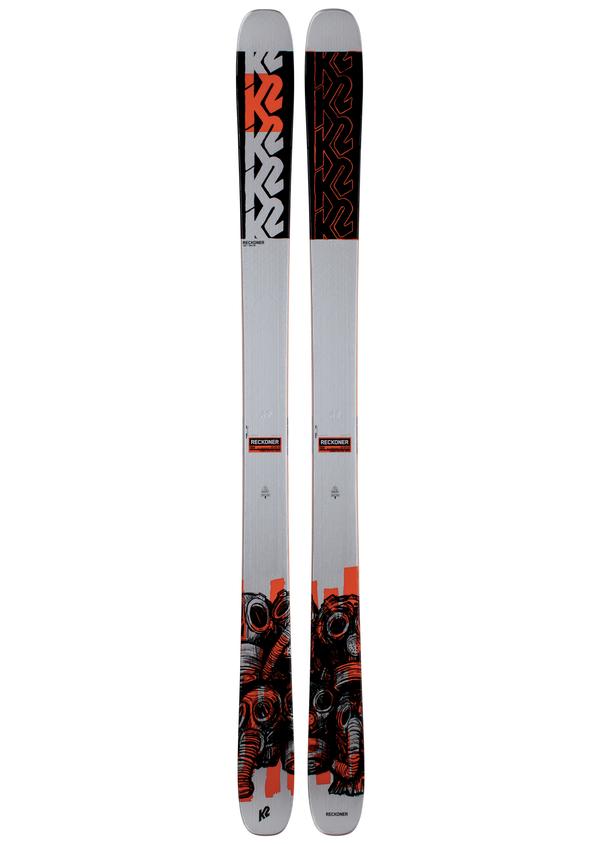
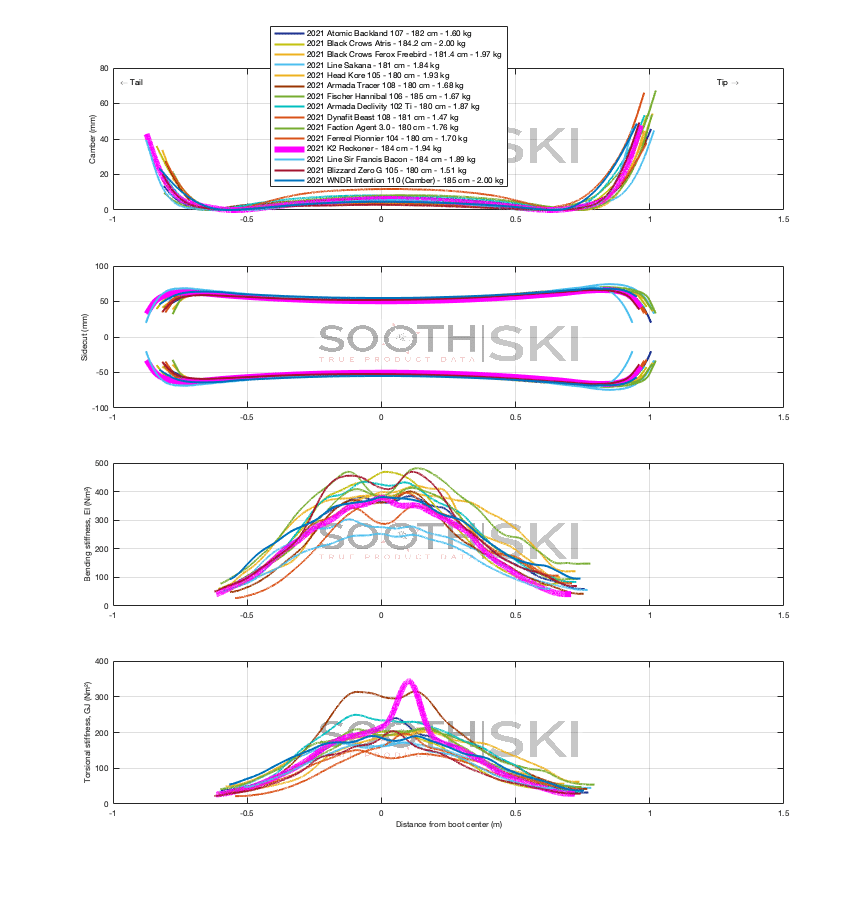
2021 Line Sir Francis Bacon 184cm
Line Sir Francis Bacon is what line is known for: flexible and playful option. Clearly the most flexible option in bending and also the shortest radius with the Sakana and the Ferreol Pionnier 104. This is not a ski meant to go fast, it’s meant to be playful, agile, fun to ski even in the park. The tail area is within the average of the selection for torsional stiffness values, this provides good edge grip at the end of the turns.
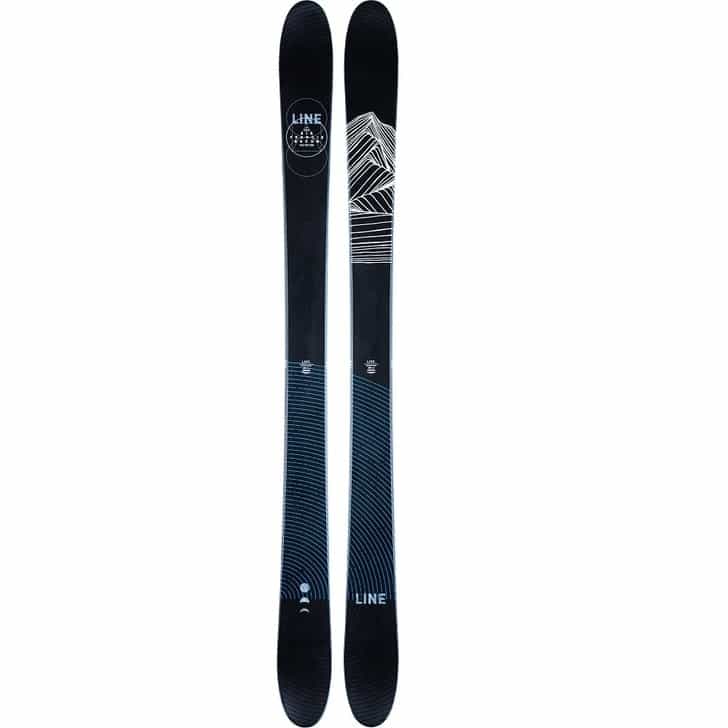
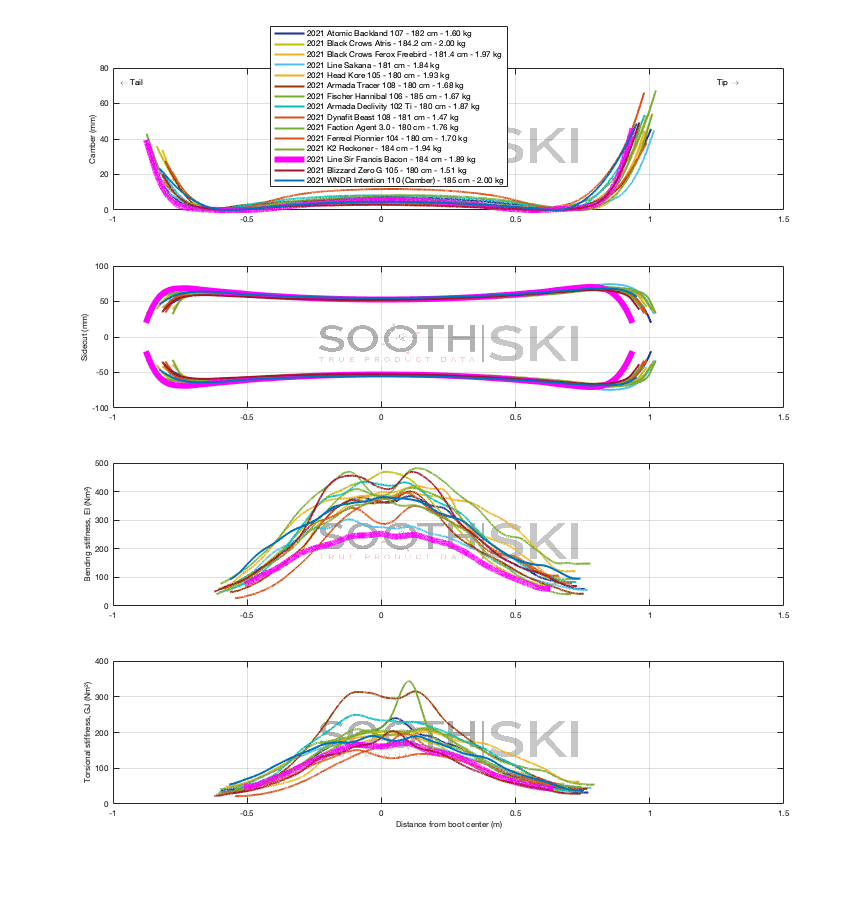
2021 Line Sakana 181cm
The Sakana is not as flexible as we could anticipate, based on Line’s reputation of producing flexible playful skis. The Sakana has actually one of the stiffest tail areas for both bending and torsional values. Across the entire ski, the torsional stiffness is high and will provide great edge grip. As for the bending stiffness in the front area, it’s very flexible, so the comfort speed zone for this ski is lower, making it more a playful type of ski.
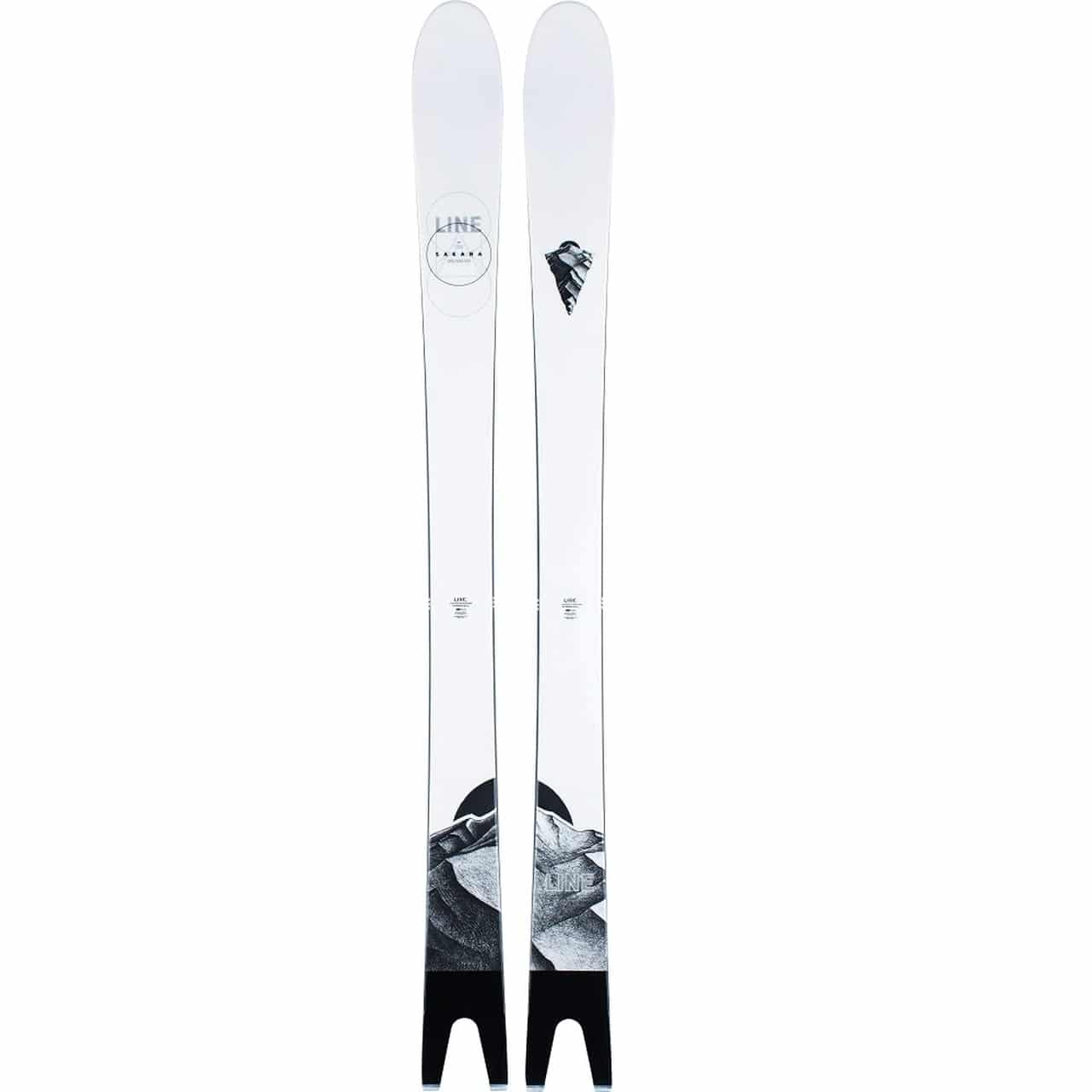
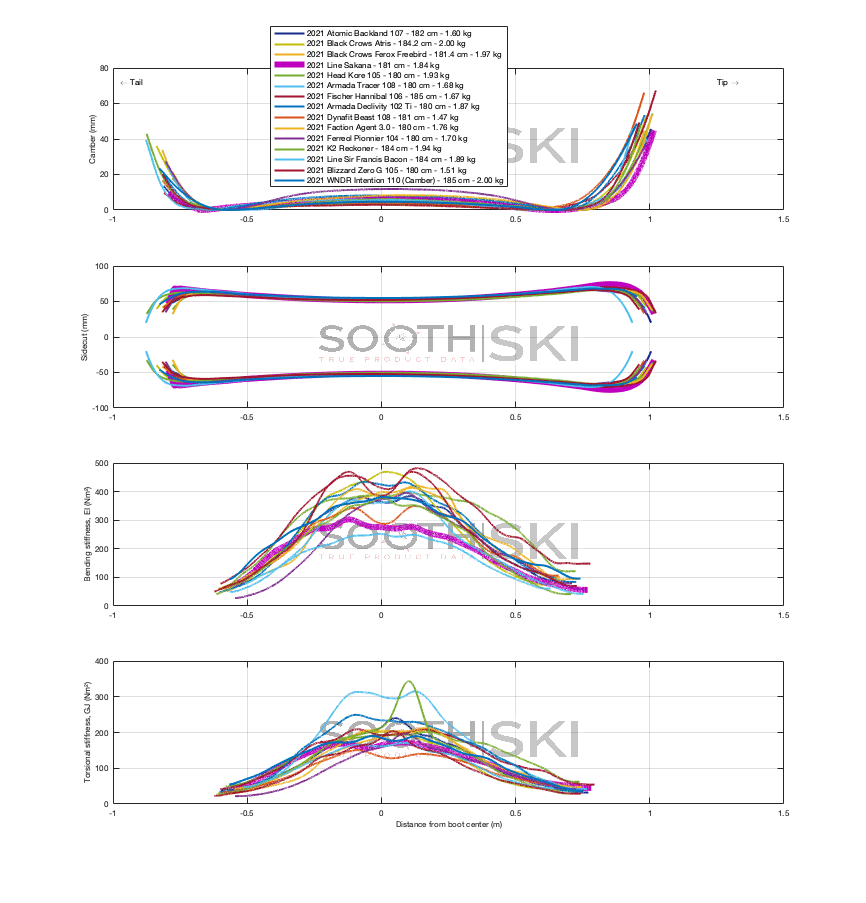
2021 WNDR Alpine Intention 110 (camber) 185
WNDR Alpine is also new to our database this year and we’re very proud to say they have developed their skis using Sooth’s technology of measuring. The Intention 110 comes in 2 versions: camber and rocker. It has slightly above average bending and torsional stiffness values. The tail area is stiffer in both bending and torsional values. This represents a superior support, especially for those long turns at high speed. One considerable benefit of choosing this brand is to formalize your environmental values, as this brand is eco-friendly oriented, choosing to R&D new material that are less harmful. Some say they “want” and some actually do it, WNDR Alpine is a doer.
